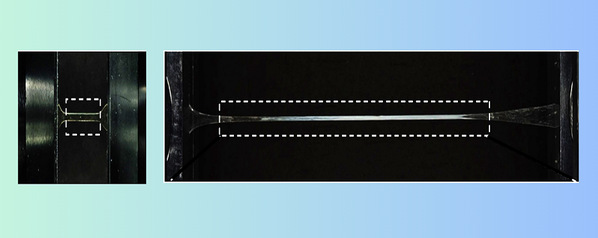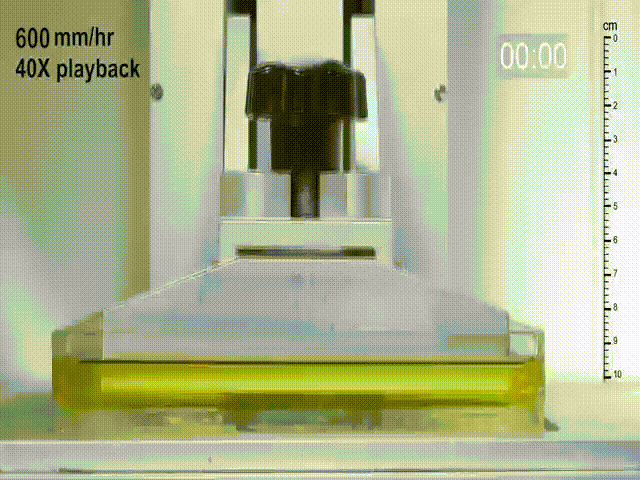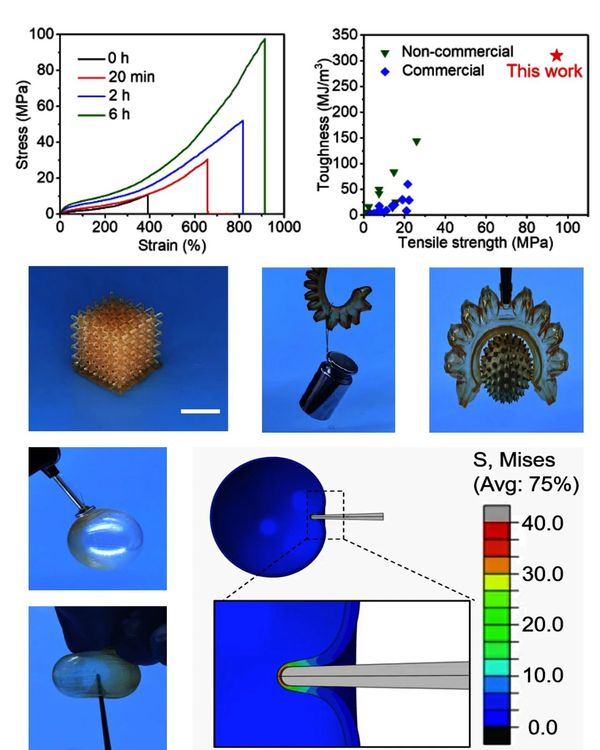Imagine stretching a rubber band as hard as you can without breaking it. A research team led by Prof. XIE Tao and WU Jingjun from Zhejiang University’s College of Chemical and Biological Engineering has 3D-printed a “super rubber band” capable of stretching to nine times its original length. Remarkably, this tiny band, only about 1 mm in diameter, can lift a 10 kg bag of rice, far outperforming other elastomers produced through 3D photo-curing.

Fig.1: Photographic image of the Super Rubber Band before and after stretching. The left image shows before stretching, and the right image shows after stretching.
This super rubber band was created with a cutting-edge photosensitive resin. The team designed the material with dynamic chemical bonds that allow new bonds and topological structures to form when heated after printing, resulting in a stronger and more durable product. This discovery opens the door to overcoming long-standing material limitations in 3D printing, paving the way for the large-scale manufacturing of high-performance products.
Since its inception, 3D printing has been celebrated for its ability to produce “free-form” designs. However, early iterations of the technology suffered from slow printing speeds and poor product performance, hindering extensive applications. Photo-curing 3D printing made a breakthrough in terms of efficiency, with products being developed from materials after exposure — much like developing photographs — significantly speeding up the process and advancing the technology toward industrial use.

Photo-curing 3D printing process
Yet, a critical flaw remained: photo-curing 3D prints were often brittle and prone to crack, thereby restricting their application to low-demand areas like model making. Could 3D printing be only aesthetically appealing yet in the absence of real-world durability?
The research team zeroed in on a crucial aspect: improving the materials used in 3D printing. WU Jingjun explained that photo-curing 3D printing relies on photosensitive resin —similar to the material used in dental fillings. In dentistry, liquid resin is placed in tooth cavities and hardens after a few seconds of ultraviolet light exposure, becoming part of the tooth. The team realized that while 3D printing equipment had advanced significantly, the materials themselves lagged far behind — a gap they believed was key to unlocking the full potential of the technology.
WU Jingjun described the challenge as a paradox. “You need fast printing speeds and high product performance, but these goals pull molecular design in opposite directions,” he said. Specifically speaking, photo-curing calls for quick reactions, which means multi-functional liquid resins should be utilized. However, this often brings about increased crosslinking density, which renders the printed material brittle. Conventional approaches to toughening materials, such as increasing molecular weight or introducing multiple hydrogen bonds, tend to increase viscosity and slow down the flow of the resin.
Prof. XIE Tao offered a solution: break the paradox into stages. “We focus on reactivity and fluidity during the printing phase, and employ post-processing to toughen the material,” Xie explained. This approach builds on the team’s recent concept — the Topology Isomerization Network (TIN). Xie noted that the topological structure of polymers determines their properties. While most polymers have fixed topologies after synthesis, by introducing reversible “dynamic covalent bonds,” the material can form new bonds under conditions like heat or light, allowing the network’s topology to evolve and giving the material different properties at different stages of its life.
Thus, the challenge of improving material performance shifted to designing dynamic polymer networks. FANG Zizheng, the study’s lead author, explained their approach: they integrated dynamic hindered urea bonds, polyurethane segments, and carboxyl groups into the existing photosensitive resin molecules. Initially, these components remain “dormant” during the pre-printing stage. Once the object is printed, it is placed in a 90°C oven for a final transformation.
As the material “bakes,” it doesn’t change shape, but inside, its molecular bonds are actively rearranging. These dynamic exchanges create new chemical bonds and reshape the material's internal structure, making it progressively stronger and more resilient.
Specifically, the hindered urea bonds in the material break apart, creating reactive isocyanate groups. These groups then react with side-chain carboxyl groups to form amide bonds and, in the presence of water, produce urea bonds. As these dynamic chemical exchanges occur, the material’s internal structure alters, triggering three key toughening mechanisms. First, the material shifts from a single network to an interpenetrating network. Second, multiple types of hydrogen bonds form, including amide, urea, and urethane bonds, each with different strengths. Third, microphase separation within the material becomes more pronounced, further enhancing its toughness.
“These three toughening mechanisms are well-known for their ability to boost material durability,” WU Jingjun explained. “We embedded them directly into the molecular structure, allowing them to work together synergistically after the material is printed, as dynamic bonds exchange and the network topology evolves.”
This triple-toughening process radically enhances the mechanical performance of photo-curing 3D prints, transforming previously fragile products into resilient ones. The researchers tested this effect by printing a rubber band with the new resin and putting it through rigorous endurance tests. The results were remarkable in that the band could stretch to nine times its original length and withstand a tensile force of 94 MPa without breaking. Its strength and toughness outperformed anything previously reported in scientific literature or commercial products.
In fact, WU Jingjun noted that their experiments used rubber bands thinner than a mechanical pencil lead. When scaled up, a band with just a 1 square millimeter cross-sectional area could lift a 10 kg bag of rice.

Mechanical properties of tough elastomers by photo-curing 3D printing
These impressive results show that photo-curing 3D printing technology has finally pushed past material limitations and is now ready for broader, more ambitious applications. To demonstrate the potential of their ultra-tough “super rubber band” material, the researchers tested it in ways that would have been inconceivable for previous 3D-printed materials: a balloon punctured without bursting, a hook supporting heavy loads without bending, and a hand gripping a spiked copper ball — all feats that highlight its unmatched strength and flexibility.
“3D printing doesn’t have to compromise mechanical performance,” said Prof. XIE Tao. The team’s innovative use of dynamic covalent networks effectively resolves the long-standing tradeoff between speed and strength, providing a novel approach to creating tough and durable materials. This breakthrough not only removes a key barrier to scaling up 3D printing for industrial use but also opens up the avenue to harnessing similar techniques to enhance other materials, thereby creating exciting new possibilities for the future of material design.
More information: Zizheng Fang. et al. 3D printable elastomers with exceptional strength and toughness, Nature (2024). DOI: 10.1038/s41586-024-07588-6
Adapted and translated from the article by ZHOU Wei
Translator: FANG Fumin
Photo: The research team
Editor: TIAN Minjie
(From ZJU NEWSROOM)

